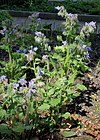Note: This is a project under development. The articles on this wiki are just being initiated and broadly incomplete. You can Help creating new pages.
Difference between revisions of "Borago officinalis"
(→References) |
(→Photo Gallery) |
||
| Line 63: | Line 63: | ||
File:Borago officinalis Prague 2014 1.jpg | File:Borago officinalis Prague 2014 1.jpg | ||
File:Borago officinalis 'Borage' (Boraginaceae) plant.JPG | File:Borago officinalis 'Borage' (Boraginaceae) plant.JPG | ||
| − | File:Borageo with bumblebee.jpg | + | File:Borageo with bumblebee.jpg |
File:Close-up of plant in field - geograph.org.uk - 503603.jpg | File:Close-up of plant in field - geograph.org.uk - 503603.jpg | ||
</gallery> | </gallery> | ||
Revision as of 19:22, 7 September 2020
Borago officinalis is an erect to spreading, annual to biennial plant. It can grow up to 60cm tall. Borage has a wide range of uses as a culinary and medicinal herb. It can be harvested from the wild it is more commonly cultivated in the herb garden. Various named forms have been developed.
Contents
- 1 Uses
- 2 Parts Used
- 3 Chemical Composition
- 4 Common names
- 5 Properties
- 6 Habit
- 7 Identification
- 8 List of Ayurvedic medicine in which the herb is used
- 9 Where to get the saplings
- 10 Mode of Propagation
- 11 How to plant/cultivate
- 12 Commonly seen growing in areas
- 13 Photo Gallery
- 14 References
- 15 External Links
Uses
Fevers, Chest problems, Kidney problems, Liver problems, Inflammatory swellings, Lowers blood pressure, Skin complaints.
Parts Used
Chemical Composition
Borage (Borago officinalis) is an annual herb which is cultivated for medicinal and culinary uses, although it is commercially cultivated for borage seed oil.[1]
Common names
| Language | Common name |
|---|---|
| Kannada | |
| Hindi | |
| Malayalam | |
| Tamil | |
| Telugu | |
| Marathi | |
| Gujarathi | |
| Punjabi | |
| Kashmiri | |
| Sanskrit | |
| English |
Properties
Reference: Dravya - Substance, Rasa - Taste, Guna - Qualities, Veerya - Potency, Vipaka - Post-digesion effect, Karma - Pharmacological activity, Prabhava - Therepeutics.
Dravya
Rasa
Guna
Veerya
Vipaka
Karma
Prabhava
Habit
Identification
Leaf
| Kind | Shape | Feature |
|---|---|---|
Flower
| Type | Size | Color and composition | Stamen | More information |
|---|---|---|---|---|
| {{{5}}} |
Fruit
| Type | Size | Mass | Appearance | Seeds | More information |
|---|---|---|---|---|---|
Other features
List of Ayurvedic medicine in which the herb is used
Where to get the saplings
Mode of Propagation
How to plant/cultivate
A very easily grown plant, succeeding in ordinary garden soil preferring a dry soil.[3]
Commonly seen growing in areas
Photo Gallery
References
- ↑ Chemical composition
- ↑ ["morphology"]
- ↑ Cultivation
External Links
- Ayurvedic Herbs known to be helpful to treat Fevers
- Ayurvedic Herbs known to be helpful to treat Chest problems
- Ayurvedic Herbs known to be helpful to treat Kidney problems
- Ayurvedic Herbs known to be helpful to treat Liver problems
- Ayurvedic Herbs known to be helpful to treat Inflammatory swellings
- Ayurvedic Herbs known to be helpful to treat Lowers blood pressure
- Ayurvedic Herbs known to be helpful to treat Skin complaints
- Herbs with Leaves used in medicine
- Herbs with Dried stem used in medicine
- Herbs with Flower used in medicine
- Habit - Biennial
- Index of Plants which can be propagated by Seeds
- Herbs that are commonly seen in the region of Waste ground
- Herbs
- Pages without herbs images







